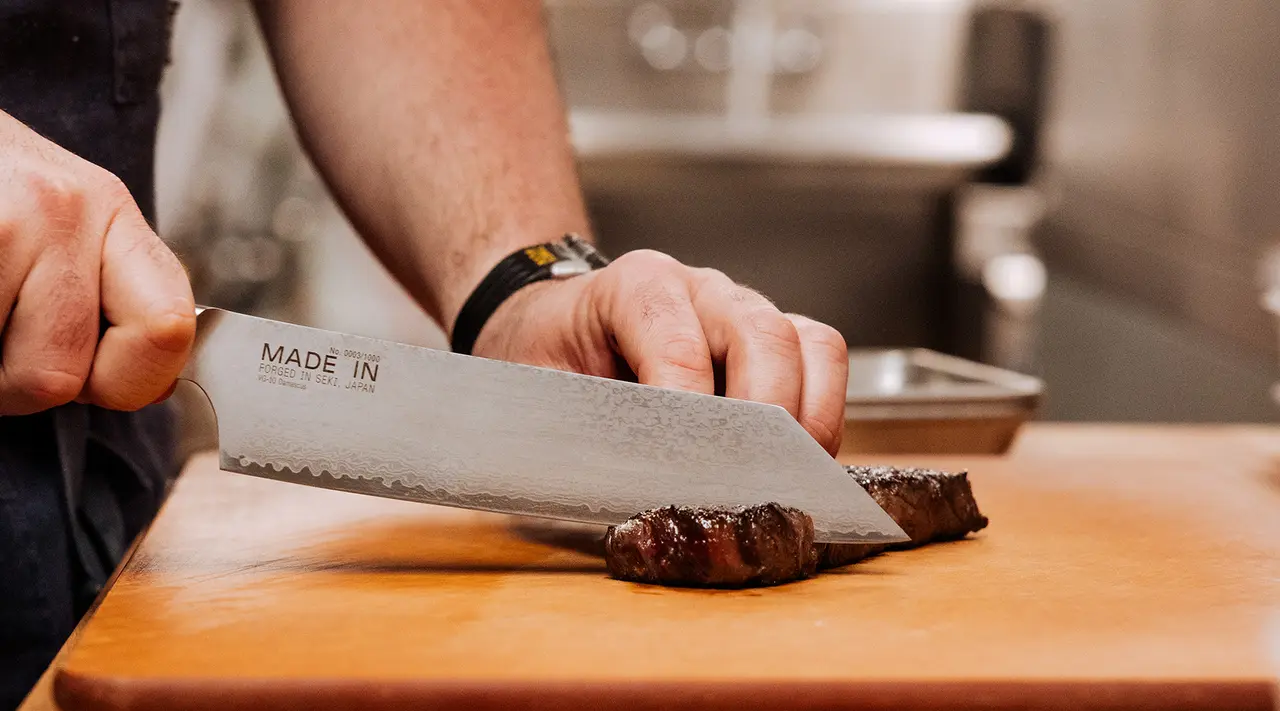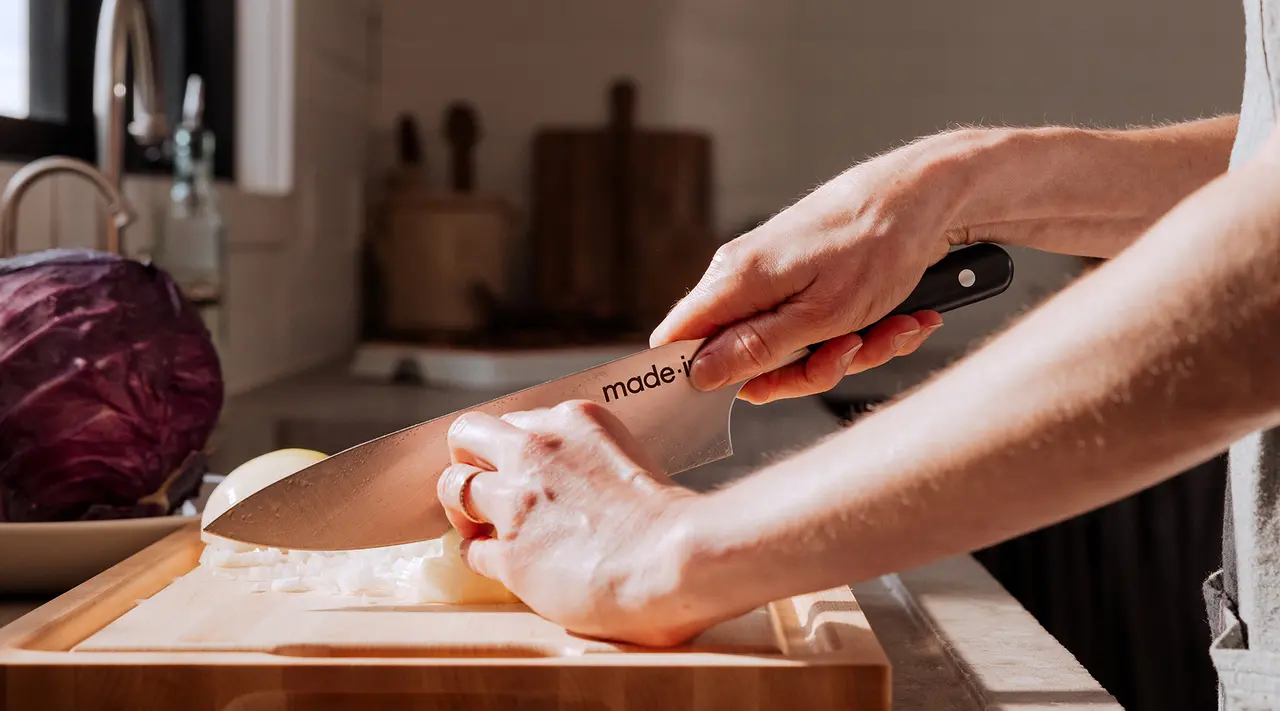A good kitchen knife can make or break you. Remember the last time you had to use a miraculously dull knife to prep some vegetables at a vacation rental or your beloved relative’s home? Then you know all too well how important it is to have a good, sharp knife you can depend on, one that feels almost like an extension of your arm as you use it.
Whether you’re looking for your next knife or it’s simply time for an upgrade, Japanese and German knives can both be excellently crafted options. Choosing between the two depends on your cooking style and what you value in a knife: Japanese blades, with a thin shape, prioritize precision, while thicker German knives are a bit more utilitarian. Read on to learn the main differences between Japanese versus German knives.
Understanding Japanese Knives

Japan has a rich history of crafting knives from steel. While Japanese knives can certainly be used for multiple types of kitchen tasks, their blades are designed to be used for specific cuts. We’ll dive into the variety below.
History and Craftsmanship
Knife (and sword) making is a century’s old tradition in Japan, with many of the country’s sword makers transitioning to knife production after an 1876 prohibition on carrying weapons in public. Knife making remains hugely important in Japan to this day.
Key Characteristics
Japanese knives feature thin, straight blades designed for slicing, trimming, and mincing. Their blades are typically harder than German and other western knives, meaning they don’t need to be sharpened or honed as often but that they can be more susceptible to chipping.
The blades typically feature a single beveled edge, providing maximum precision but also more care on the user’s part (they’re usually meant to be used with your right hand). They are also typically partial tang, meaning the steel doesn't extend all the way through the handle, to be more lightweight.
Japanese knives are made with specific purposes in mind. Traditional shapes include:
- Deba: With a thick blade, these are used to debone fish and remove their heads. Their length is 5.9 to 11.8 inches.
- Yanagi and Tako: With a length of 8.2 to 13 inches, these knives are made to slice boneless fish filets for sashimi. Tako blades are more rectangular in shape than the Yanagi.
- Usuba: These blades are similar to our Nakiri design, made to cut vegetables with ease. Usubas are single bevel, with a length of 5.9 to 8.2 inches.
- Gyuto: The double bevel Japanese version of the Chef Knife, the Gyuto was adapted from Western style knives in the mid-18th century, along with an increase in eating (and thus preparing) beef.
- Kiritsuke: With a reverse tanto tip (an angled design that allows for more precise cuts), these typically have single-bevel blades meant for raw fish and vegetables, while the similarly designed Bunka have a double bevel, making it a bit more versatile.
Pros and Cons of Japanese Knives
The biggest advantage of using a Japanese knife is the precision it offers.. While a chef knife can also chop vegetables, the nakiri, with the edge of its blade nearly flat, allows you to make long cuts by pressing straight down, rather than rocking back and forth with a chef knife. It can chop any vegetable you put in front of it more efficiently than other knives.
Japanese knives tend to be lighter than German knives, too, making them that much more easy to work with. Depending on the blade's manufacturing (some steels are harder than others), maintaining the blade’s sharpness might be trickier. While a harder material means the edge will stay sharp longer, it also means they are more brittle and thus easier to chip.
Exploring German Knives

Like Japan, Germany is globally renowned for their premium knives. German knives tend to be more all-purpose than Japanese knives, though you’ll of course find specific-use blades meant for certain tasks. We’ll dive into a few key notes on German (and other Western-made) knives below.
History and Heritage
Knife making in Germany goes back centuries. One city, Solingen—known as the City of Blades—has served as the center of knife making since the Middle Ages. (It’s also the home of well-known brands like Wüsthof and Zwilling J. A. Henckels.) German knife makers widely influenced others across Europe and America, with western knifemakers adapting German designs.
Main Features
Made from corrosion- and rust-resistant stainless steel, German knives use a softer steel, which requires more steel in the blade and thus makes for a heavier knife. This relative softness makes the knife easier to sharpen, while the thickness makes the blade quite durable.
German blades are curved (think a chef knife), designed for rocking back and forth to chop and dice. A sharp point makes German knives ideal for working with meat, and their double beveled edges can be used in either the right or left hand.
While some knives have specific purposes, like a boning knife or a serrated bread knife, in general German knives are very versatile and able to accommodate a wide variety of chopping and slicing techniques.
Advantages and Considerations of German Knives
The thick, robust German-style blades are very durable. With proper maintenance and routine honing, your knife will last for years. (It’s also slightly easier to maintain a German knife than Japanese, though like anything, all it takes is a little practice.)
If you’ve got limited space to hold a wide variety of knives, a German knife is a good investment as it’s so versatile across the board. German knives do tend to be heavier, though, which might be a drawback.
Japanese vs. German Knives: Performance Comparison

A few key differences between Japanese versus German knives affect the performance of each.
Cutting Capabilities
German knives feature a curved blade, while Japanese knives have straighter edges. This makes a difference in your cutting motion: with a curved blade, you’ll rock back and forth to chop. With a straighter blade, you’ll cut straight down, utilizing the entire blade at once.
Precision and Control
Since they’re designed with specific tasks in mind, Japanese knives offer more precision for those tasks. Our Japanese-made Santoku Knife works well for prepping meat, fish, and vegetables, while the Nakiri excels at all manners of vegetables, including large roots and squash.
Versatility
German knives, on the other hand, are more versatile, able to both debone a chicken and julienne a carrot with ease, while Japanese blades are typically best for specific purposes. For example, the German-style Chef Knife can handle small projects like mincing herbs and onions to larger tasks like chopping up a pumpkin. Paring Knives are great at slicing through smaller vegetables with precision, and also work well for peeling vegetables.
Maintenance Requirements
Since Japanese knives are made with a harder steel, making them slightly brittle, they should be sharpened on a whetstone, aka a sharpening stone. We recommend learning to use a sharpening stone for all of our knives, whether Japanese or German.
This may seem intimidating, but you’ll become comfortable with a little practice—and you can check out our guide to walk you through how to do it. Remember, though, you should only need to sharpen your knives about twice a year; for the rest of the year, it’s best to use a honing steel to keep the blades in shape.
Which Kind of Knife Is Best for You?

Now that you know the key differences between Japanese versus German knives, how will you decide which is best for you? First think about the types of cutting and kitchen prep you tend to do: if you want something all purpose, able to tackle a wide range of tasks, go for a versatile German blade.
If you do a lot of vegetable prep, then a Japanese knife like our Nakiri would be a good choice. Also think of the weight: German knives are a little heavier than Japanese, so it depends if you prefer that extra weight or like the ease of a lighter device.
In terms of budget, a good, well-made knife can be an investment, but with proper maintenance, it’s an investment you’ll only need to make once. (A good knife makes a great gift, too.)
Both our Japanese- and German-style knives come in a variety of handle choices, from a bold pomme red to timeless olive wood, so you’ll easily find something to match your kitchen aesthetic.
Ready to Chop?
There are several differences between Japanese versus German knives, but quality manufacturing makes either a good choice to add to your kitchen. If you’re choosing between the two, think of your cooking style to help you decide. Browse through our collections of full tang, fully forged blades and get ready to slice, dice, and mince with ease.





























